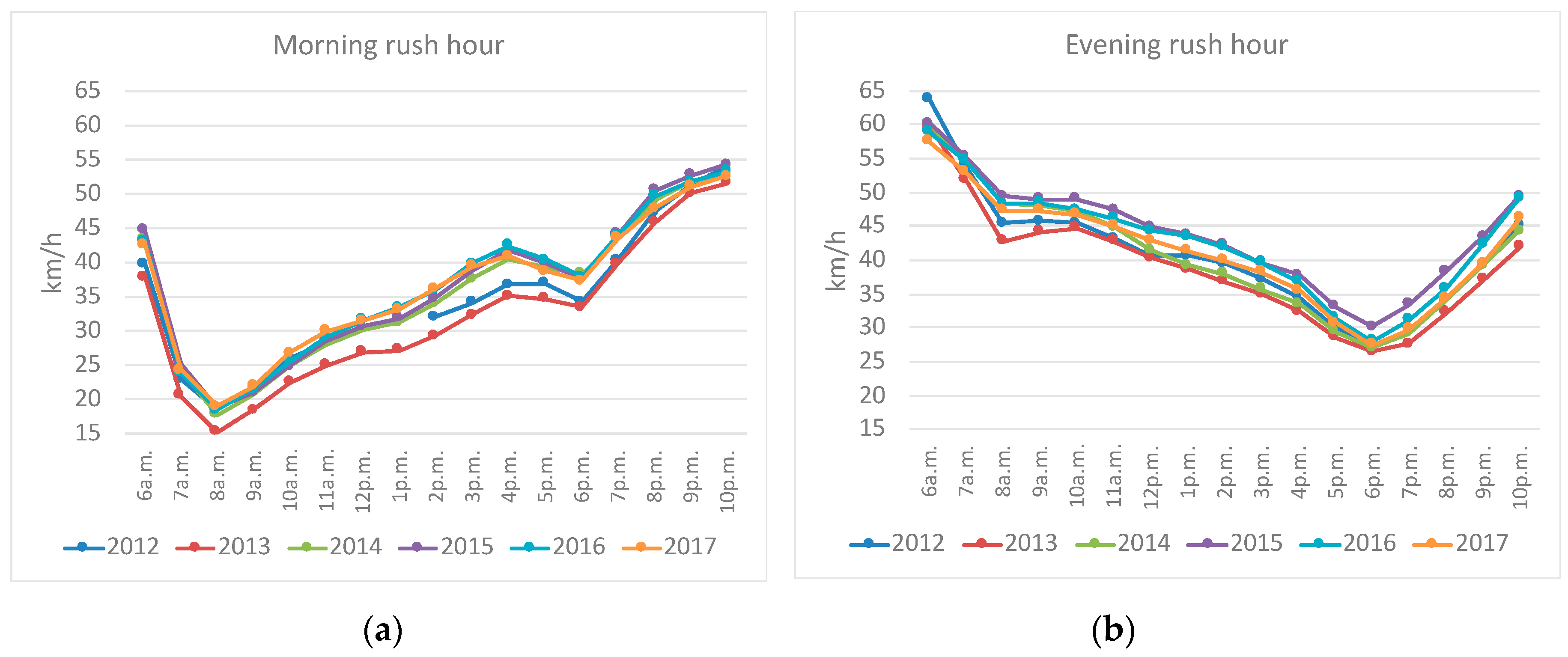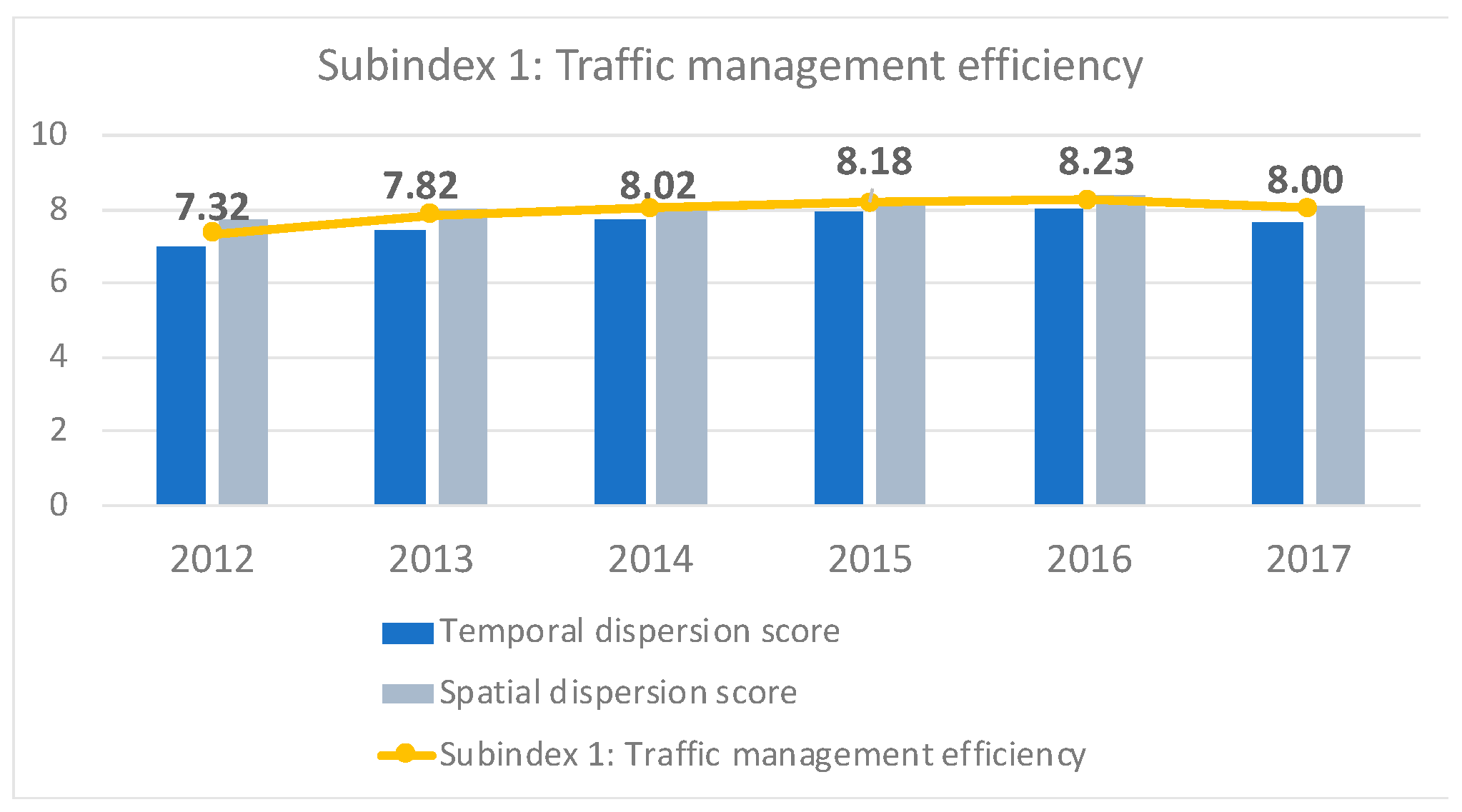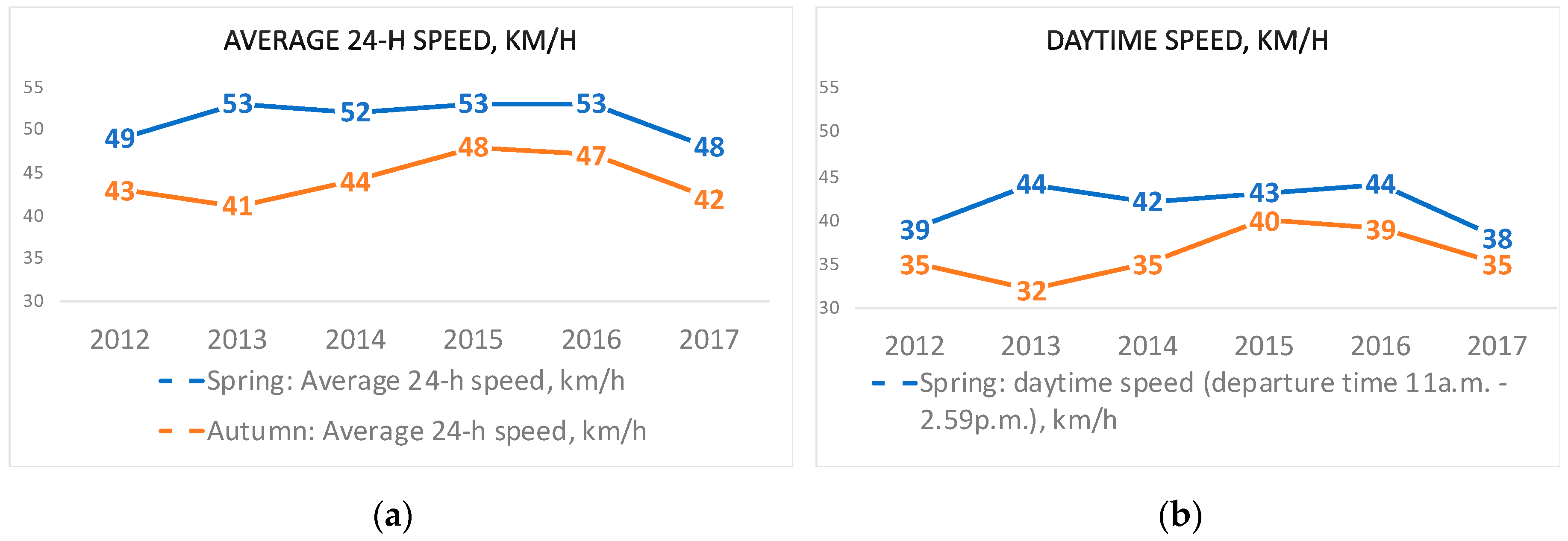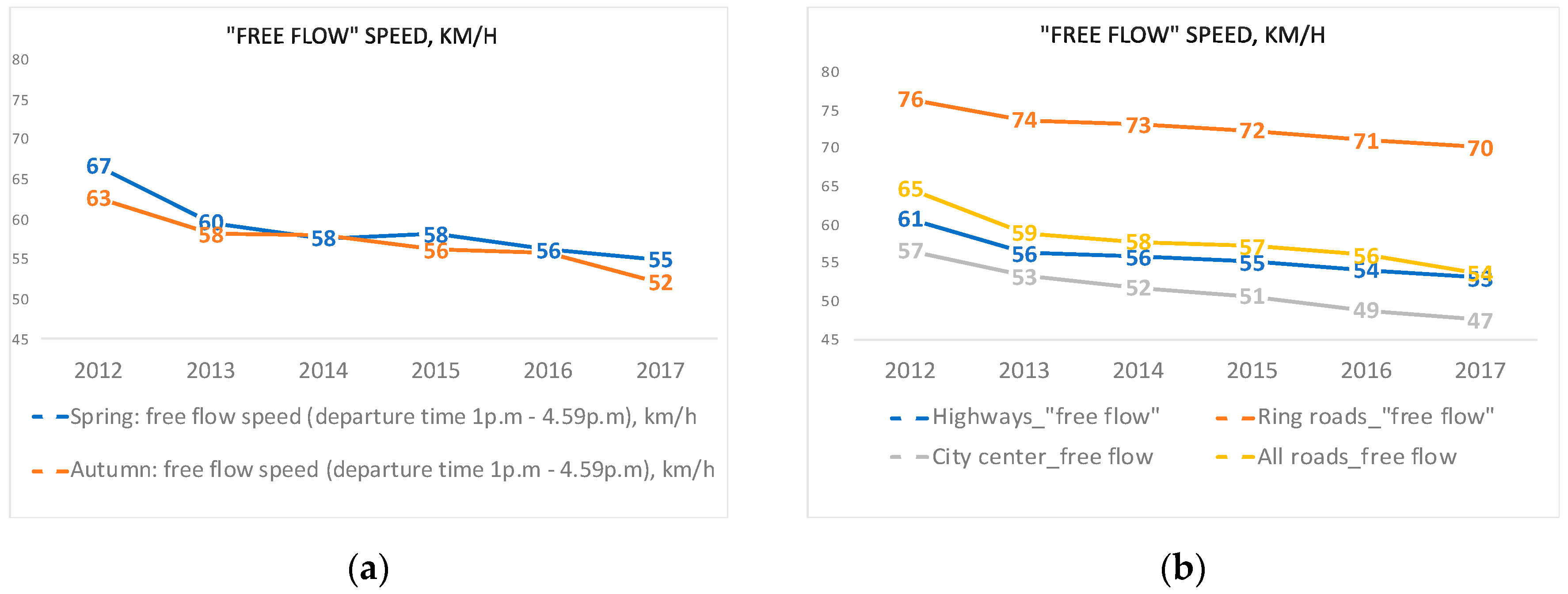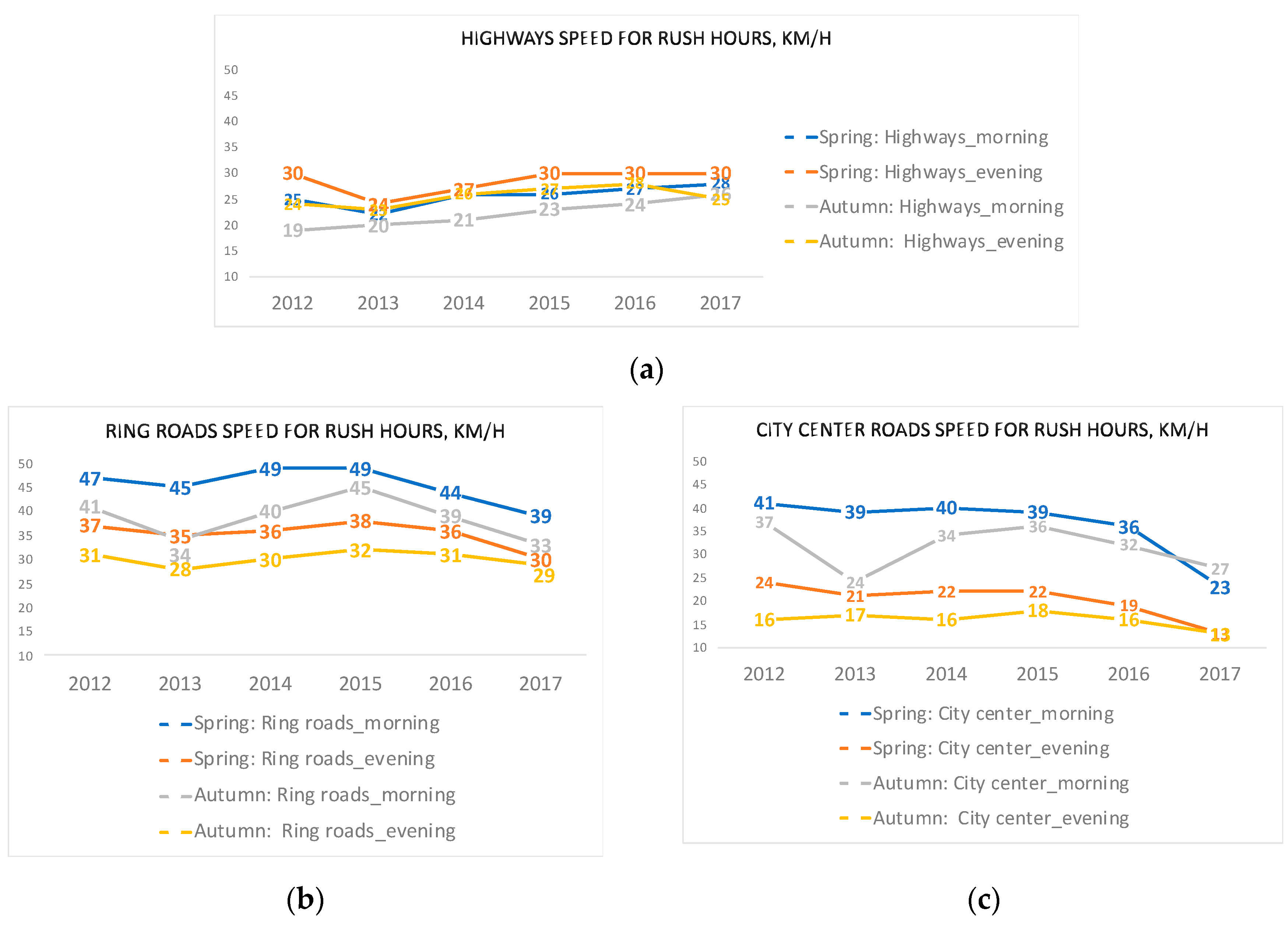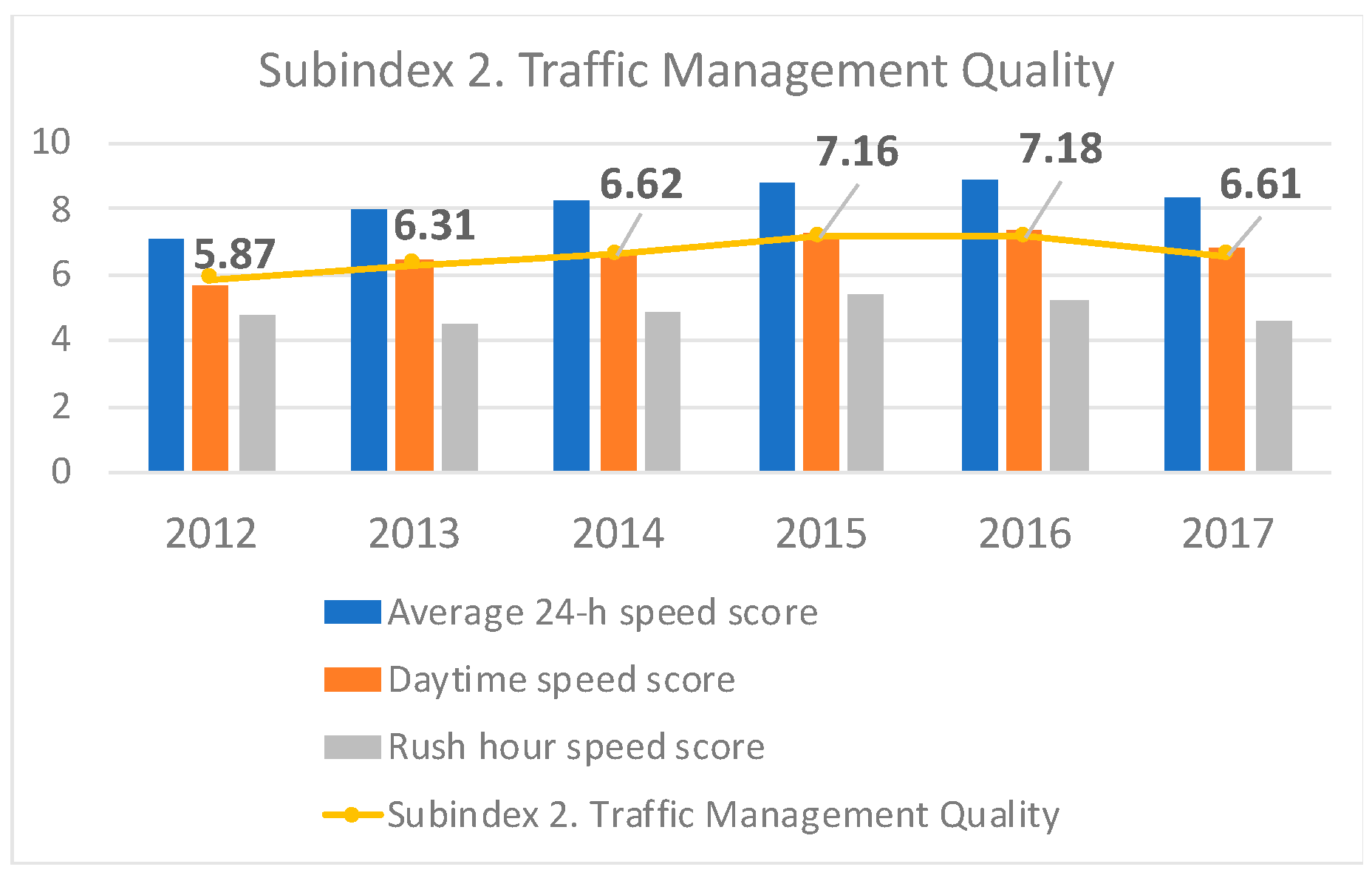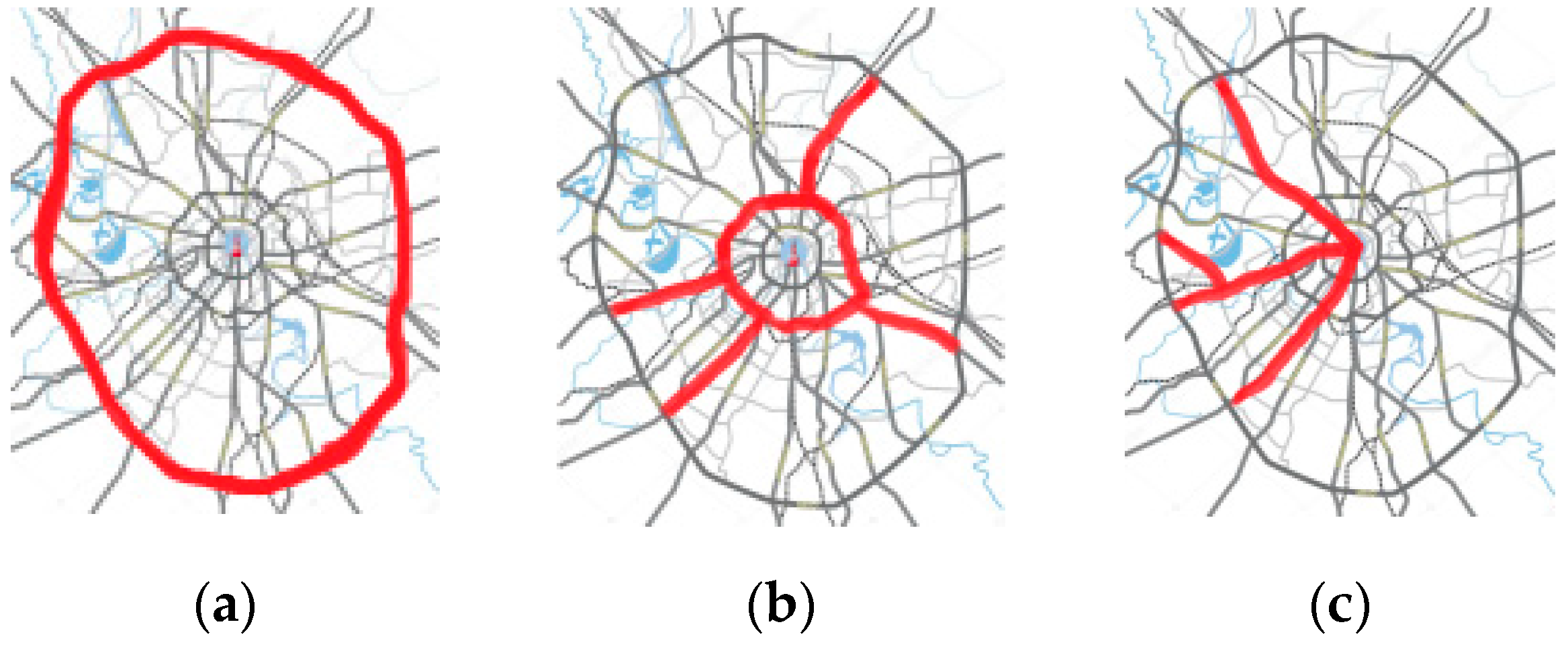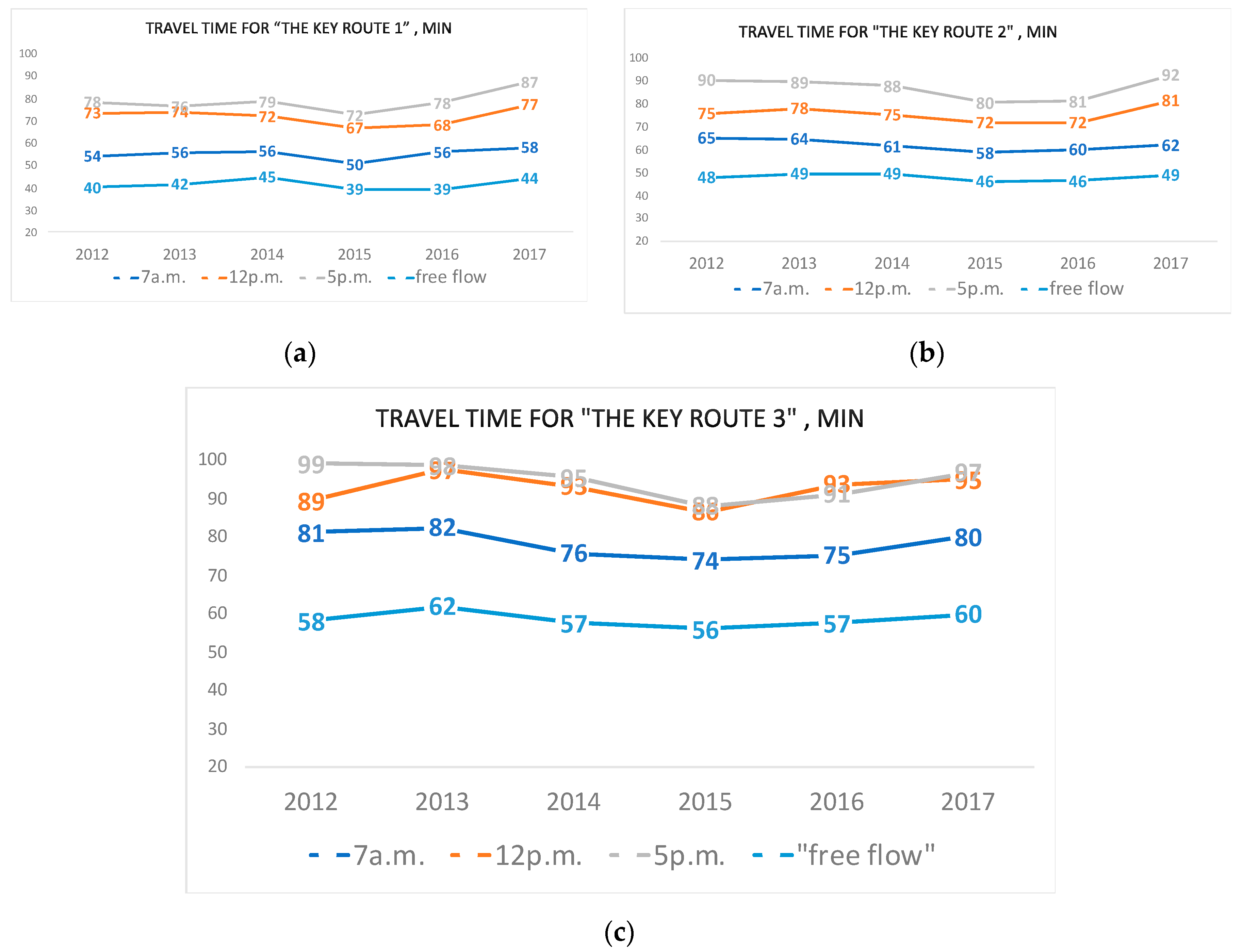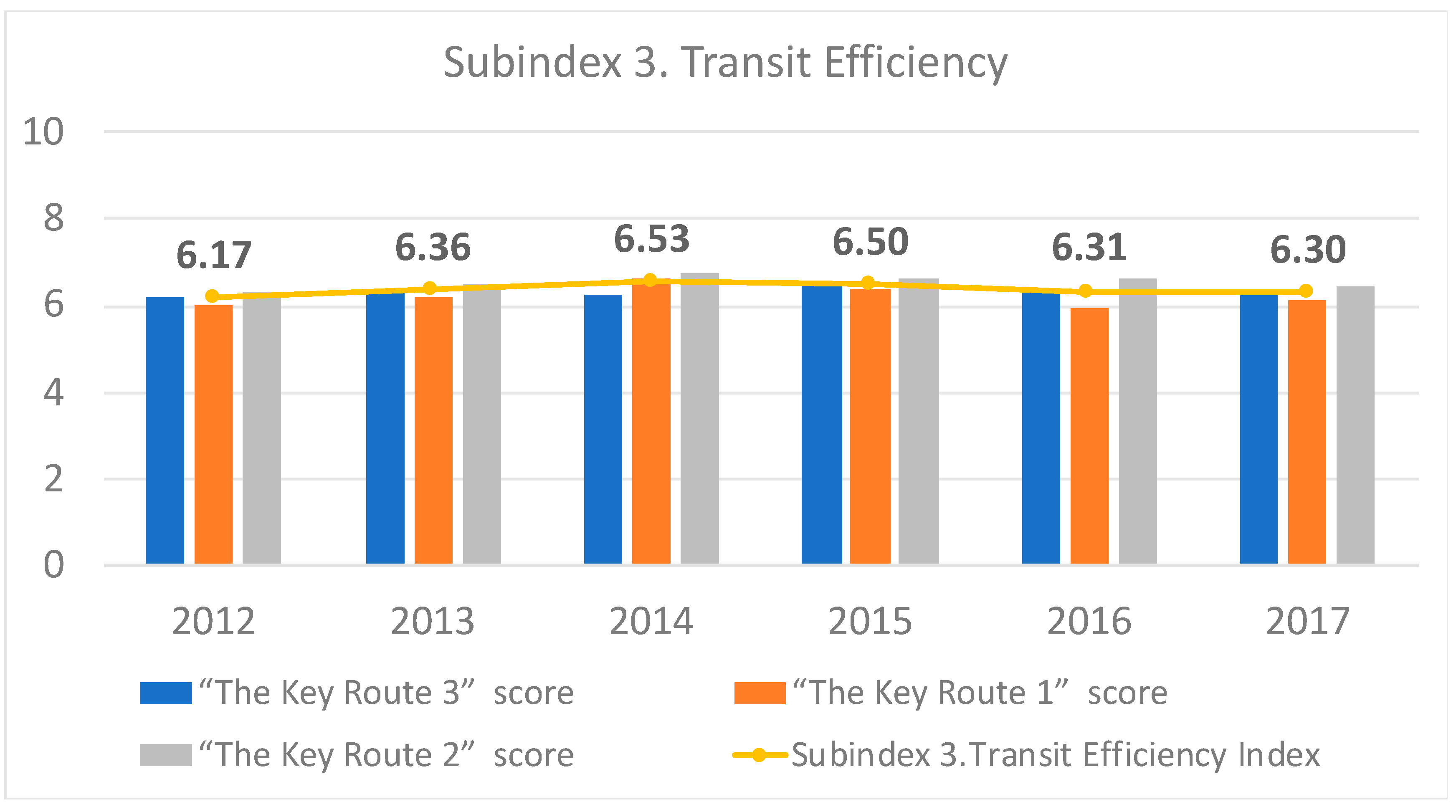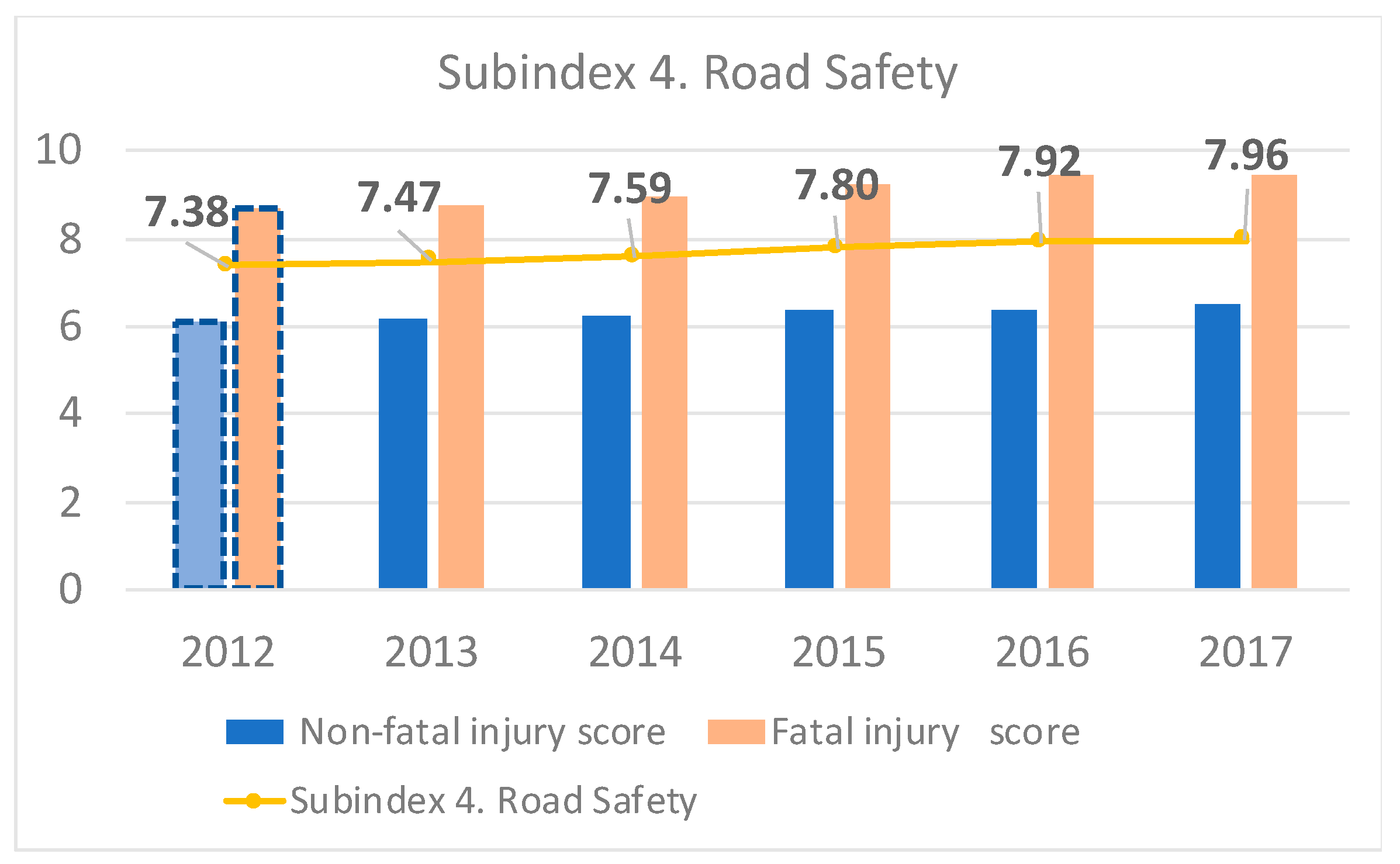1. Introduction
The urban transportation complex is a dynamically changing system, influenced by many factors, including construction of new interchanges and roads, changes in carriageway and footway widths, implementation of paid parking spaces, bus lanes and bike paths, etc., (Yandex [
1]).
Integral indexes are frequently used to assess the level of transportation complex development (Litman [
2]). Such indexes are developed by official statistical agencies or other public authorities, international and national research centers, independent analytical companies; they become an important criterion for assessing life quality in cities, to be included into global competitiveness ratings of countries and regions. Indexes are also highly instrumental for the assessment of transport situation in a city or a country in time.
Significant global experience was accumulated in integral indexes. The selection of the indicators, included in indexes, is related to the scope of the index and data availability (depends on existence of a specific data sources). The specialized indexes are: the Transportation Services Index [
3], Logistics Performance Index [
4] and Emerging Markets Logistics Index [
5] rank the freight and logistics sectors; Urban Mobility Index [
6] and The Siemens’ Green Cities Index [
7]—ecological situation; Overall Global Mobility Ranking [
8] and The Deloitte City Mobility Index [
9]—mobility level; TomTom Traffic Index [
10], INRIX [
11] and Travel Time Index [
12]—traffic congestion.
The indexes are based on indicators, grouped by different types and categories. For the purposes of Integral Index of Traffic Planning construction, the most important are transport and mobility indicators. Casey and Norwood [
13] define mobility by using several key groups of indicators: the travel time, lost time, reliability of the system, the status of the transport system and travel costs. The optional indicators are: congestion-related travel time, quantity of trips, modal split, transit time required and transit efficiency. In Imran and Low [
14] the transport indicators are related to the non-motorized transport, car ownership, average travel time, traffic volume and vehicle status. Barker et al. [
15] analyses the sustainability of the transport system and mobility using the indicators which are defined in terms of travel time i.e., congestion, transport-generated expenditure, casualties of traffic accidents, energy consumption and polluting emissions. The key indicator is the number of vehicles–kilometers. For the needs of assessing the urban mobility in Lyon [
16], a set of indicators is defined to create a relevant and simple system, connected to the existing statistical database. The indicators are grouped in four categories, related to the mobility, economy, society and environment. The mobility indicators include: the number of trips, travel time, travel purpose, modal split, daily average distance travelled by the motorized and non-motorized trips and average speed. Kaparis and Bell [
17,
18] defined a set of indicators intended for the traffic management and the Intelligent Transport Systems. The group of indicators called “Traffic Efficiency” deals with mobility defined by 14 indicators: the average duration of a road trip to the appropriate point of interest, the average duration of trips to the appropriate point of interest carried out by using the public passenger transport system, the capacity/supply of the public transport system, the time required to switch between transport modes, the average distance between different transport modes, the time required to access the station, the average duration of a search for a parking place, the average duration of the daily trips, the average distance covered by the daily trips, the total length of the road network, the coverage of the road network by ITS services, the modal split, the share of non-motorized trips in daily commuting and the length of the transport network intended for non-motorized trips. In Casey and Norwood [
13] six frequently cited areas of mobility measures are highlighted. There are: congestion related (e.g., level of service, volume/capacity, and delay); trip time; amount of travel (vehicle miles traveled, vehicle hours traveled); mode share; transfer time; and transit performance.
For developing the Traffic Planning index for Moscow, we applied frequently used and cited transport and mobility indicators and measures, supplemented them with more specific indicators and aggregated all indicators in four groups: traffic management efficiency, traffic management quality, transit efficiency and road safety. Each group is described by a core subindex consisting of several source metrics. We also modified some of the standard indicators and measures to take into account local specifications of Moscow (such as radial-ring streets structure, huge traffic volume, significance of road accidents number) and availability of primary data for index constructing.
The structure of Integral TP Index is:
Higher value of each subindex corresponds to improving of the direction, described by subindex. To account for the contribution of various roads to the integral road system, the subindexes 1, 2 and 4 use the traffic volumes. The splitting of streets by type (highways, rings, center) and different transit routes was used in subindexes 2 and 3, respectively, and allows to consider the special case of Moscow radial-ring road structure. The significance of road accidents was considered in subindex 4.
1.1. Subindex 1. Traffic Management Efficiency
Subindex 1 describes the traffic management efficiency. It shows how many vehicles a city can accommodate on average per day and how efficiently traffic flows are distributed in space and in time of the day. The subindex 1 evaluates long-term decisions (for example, roads planning), rather than short-term road events (accidents, short-term repairs, etc.). To assess the traffic management efficiency, several source metrics are used: traffic volume and speed dispersion (spatial and temporal).
1.1.1. Traffic Volume
Traffic volume (also referred to as intensity) is traditionally defined by the “average number of vehicles (
n) that pass a cross-section during a unit of time (
T)” (Hoogendoorn and Knoop [
19]). Dynamics of this indicator allows to account for events impacting the patterns of traffic, but not the average speed value. The traffic volume is mentioned as one of the indicators in Casey and Norwood [
13], Imran and Low [
14] and used, for example, in INRIX [
11].
In our study the traffic volume is one of the key parameters for averaging data over ensembles of roads (for example, calculation of speed for all roads, city center roads, rings, and highways). We use the total traffic volume for all city roads expressed in the total number of vehicles passing through the city per day as an additional metric for subindex 1 “The effectiveness of traffic management”.
1.1.2. Speed Dispersion
Another reference indicator used to assess the traffic management efficiency and directly reflecting the vehicles distribution uniformity on the roads is speed dispersion. Aarts et al. [
20] and Rogdriguez [
21] establish the relationship between dispersion and the probability of road traffic accidents. In Aarts et al. [
20] it was shown that the probability of accidents correlates with average flow speed and dispersion of speeds in the flow. Casey and Norwood [
13] determined the influence of the average flow speed, individual vehicle speed and dispersion of speed on the probability of death in an accident. It was shown that increase of flow dispersion matches the increase in the probably of accidents leading to fatal injuries on the road.
Our study uses data on average flow speeds for different time intervals and in different roads sections, without details of individual vehicles speeds. We considered two types of dispersion. The first type is temporal speed dispersion, illustrating the uniformity of various streets traffic during the day. The second one is spatial dispersion, which shows how evenly traffic is distributed along the city roads in a fixed time period for each hour of the day. The lower dispersion value corresponds to more uniform traffic flow distribution. The speed dispersion is used in connection with the average speed values, considering the normalized dispersion as the ratio of the absolute dispersion value to the average speed squared.
1.2. Subindex 2. Traffic Management Quality
The subindex 2 “Traffic management quality” describes the mathematical expectation of city travel time (average traffic speed) and its variation depending on time of the day (rush hour, daytime, etc.) and road type (rings, highways, central roads).
Similar subindexes are used in both theoretical and practical research internationally. Most often, the average flow speed is compared to similar benchmarks, e.g., rush hour speed, free flow speed, etc. The traffic management quality (average speed for different time intervals) is included in the following set of indexes: TomTom Traffic Index [
10], INTRIX Global Traffic Index [
11], Yandex.Navigator [
22], etc.
Feifei et al. [
23] proposes an index based on average speed measurements (“Speed performance index”). To estimate the traffic quality, the ratio of average speed to the maximum allowed road speed was used. This index evaluates the traffic congestion degree on a four-point scale with four points corresponding to the highest congestion. Su et al. [
24] explores the metric consisting of average speed weighted by the total number of vehicles. The results are divided into six groups to define different road regimes, from “traffic jam” to “free flow”. In our study the” free flow” speed (i.e., the average night speed) is used to construct the subindex 2 “Traffic management quality”. This methodology is similar to TomTom Traffic Index [
10].
1.3. Subindex 3. Transit Efficiency
Transit efficiency is represented by travel time for given key routes. The higher it is, the more time citizens lose every day. The core metric of this subindex is a special case of Hansen Accessibility Index proposed in Hansen [
25]. Taylor [
26,
27] enriched this indicator by adding economic parameters such as the average cost of delay minute, etc., and considered additional metrics related to transit efficiency: congestion index, proportion of stops time, adjustment for acceleration. The travel time indicator is also mentioned in Casey and Norwood [
13], Lyon [
16], Kaparis and Bell [
17,
18]. Our study focuses on key Moscow’s routes: from North to South, and from West to East via the Outer Ring Road, via the Third Transport Ring and typical highways. We also consider travel time from North, South, East, and West to the city center, represented by the Moscow Kremlin.
1.4. Subindex 4. Road Safety
Road safety is one of the key parameters of a transportation system. Safety can be quantitatively and qualitatively defined as the frequency and significance of traffic accidents. In Kaparias and Bell [
18], the frequency of accidents was used as a key quantitative indicator of safety. In our study, the subindex “Road safety” is based on the parameters defining the probability of fatal or non-fatal injury in road accidents. These parameters are calculated using traffic volume and the number of traffic accidents resulting in injury or death. The approach is related to indicator “casualties of traffic accidents” proposed by Barker et al. [
15].
2. Materials and Methods
Based on the analysis and systematization of international research experience in the field of transport analytics, presented in
Section 1, four aspects are covered in the Integral TP Index:
Subindex 1. Traffic management efficiency;
Subindex 2. Traffic management quality;
Subindex 3. Transit efficiency;
Subindex 4. Road safety.
Each subindex is a set of core metrics discussed in
Section 3.
Our study relies on datasets for the key roads connecting different city areas: the main radial highways, ring roads and city center roads. Various indicators were analyzed on 63 key roads in two directions (“to the city center” and “from the city center” for radial highways, “outer part” and “inner part” for ring roads) for two basic three-week periods each year from 2012 to 2017 (end of September–mid-October (“autumn”), end of April–mid-May (“spring”)) and various road types (
Section 2.2 and
Section 2.3). The choice of radial highways and ring roads was determined by the specifics of the radial-ring structure of Moscow (Schmidt [
28]). The key roads are used by Moscow citizens most often, they cover uniformly all city districts, uniformly present all road types and the available datasets of these roads are the fullest.
2.1. Data: Sources and Format
The data were provided by the Moscow Traffic Management Center, Yandex and TomTom for pre-agreed dates of 2012–2017 and streets within the Moscow Outer Ring Road including the Outer Ring Road. The data of road accidents were provided for 2013–2017. The data format varied from source to source, as described in
Appendix A.
2.2. Research Data Periods
The data covered two periods each year from 2012 to 2017:
For the “autumn” period, the number of vehicles is close to the average annual as it follows the end of vacation period in summer, while winter season limitations (ice and snow on the roads) do not have a significant effect yet. The second period (“spring”) includes long spring holidays traditional for Russia, when the citizens tend to leave the city for vacation. For this “spring” period the number of vehicles in the city decreases and so the period was chosen for comparison as being relatively uncongested.
2.3. Road Objects Types
Moscow metropolitan road network is primarily defined by the radial-ring street structure, similar to some major European cities. To account for such structure, the network objects were divided into types as follows (
Figure 1):
The data of road sections were implemented for Subindex 3. “Transit efficiency” calculation when route contained only part of the road.
2.4. Time Intervals
The following time periods were defined for time-dependent metrics:
24-h period;
Morning rush hour (7.00 a.m.–9.59 a.m.);
Evening rush hour (4.00 p.m.–7.59 p.m.);
Daytime period (11.00 a.m.–2.59 p.m.);
Night period—“free flow” (1.00 a.m.–4.59 a.m.).
2.5. Key Values Calculation
2.5.1. Average Speed
Calculating the average vehicles speed metric requires estimation of average speed for road ensembles (for example, for a group of roads called “rings”). To solve it, we used traffic volume: the contribution of different roads to the total road traffic was taken proportionally to the road (road section) traffic volume:
where
—the traffic volume, length and travel time of the i-th road section, respectively,
N—number of road sections.
When data on the traffic volume were not available, the assessment was based on the number of lanes in a given road section.
2.5.2. Speed Dispersion
Two types of dispersion were defined. The first one was called “spatial dispersion” (the time interval was fixed and the road sections were changed). The spatial dispersion for time period 6.00–6.59 is
—speed on the j-th road section in time interval 6.00–6.59 for 2012 year;
—the average speed for all road sections in time interval 6.00–6.59 for 2012 year;
—number of road sections.
The same procedure was made for 24 1-h time intervals and for all available years.
The second one is “temporal dispersion” (the road section was fixed and the time intervals were changed). The following formula was used for calculating the temporal speed dispersion for Enthusiasts Highway to the center (EHc):
—speed for the i-th time interval for Enthusiasts Highway to the center (EHc) for 2012 year,
—the average speed for all time intervals for Enthusiasts Highway to the center (EHc) for 2012 year,
—number of time intervals.
The same procedure was made for all available road sections for all available years.
For the purpose of comparison of dispersion with the square of average 24-h speed for all road sections, the dispersions were normalized:
Here, is the average 24-h speed in 2012 year for all road sections.
2.5.3. Probability of Non-Fatal or Fatal Injury in an Accident
Two reference values were used to assess traffic safety: the probabilities of receiving a non-fatal and a fatal (caused death) injury in an accident.
The probability of fatal injury is described by the ratio:
Here,
—the average number of deaths in road accidents for the 24-h in 3-weeks period for all roads:
where
is the average traffic volume for the 24 h in 3-week periods for all roads.
here,
j is the day in 3-week period.
A similar relation works for the probability of a non-fatal injury in an accident.
2.5.4. Duration of Morning and Evening Rush Hour, Daytime Period
The main characteristic for definition of rush hours is the average vehicles speed in the congested time periods. The following assumption was used: on weekdays highways are most congested towards the city center in the morning, and from the city center in the afternoon. The assumption is explained by the tendency for most citizens to live in residential areas and in the city region, and workplaces are mostly located close to the city center.
The average speed from 6.00 a.m. to 10.59 p.m. was analyzed for highways along the directions “to the city center” and “from the city center” (
Figure 2).
It is shown that the morning rush hour begins at about 7 a.m. and lasts until 10 a.m., with maximum traffic reached at 8.00–8.59 a.m. (
Figure 2a). The evening rush hour begins at about 4.00 p.m. and lasts until 7.59 p.m., maximum traffic reaches at 6.00–6.59 p.m. (
Figure 2b). Therefore, for the purposes of this research, the morning rush hour was defined from 7.00 a.m. till 9.59 a.m., evening rush hour—from 4.00 p.m. till 7.59 p.m., the daytime period—from 11.00 a.m. to 2.59 p.m.
2.6. Methodology of the Integral Traffic Management Index Constructing
The subindexes used for constructing the Integral Traffic Management Index of metropolis (
) are listed in the
Table 1.
The Integral Traffic Management Index of metropolis for each year was calculated as average of subindexes:
The base of counting the subindexes with the same weight is given in the
Section 4. “Discussion”.
2.6.1. Traffic Management Efficiency
For constructing the traffic management efficiency subindex (
), the values of temporal and spatial dispersion, as well as relative traffic volume changes, were used:
In the contributions of the spatial
and temporal
dispersion (calculated according to Equations (4) and (5) to the subindex a lower value of the normalized dispersion corresponds to a more uniform traffic:
An additional score is assigned to the traffic management efficiency subindex each year depending on the relative traffic volume changes of the year compared to the previous one:
2.6.2. Traffic Management Quality
Traffic management quality subindex is comprised of the average speed values, including 24-h average, daytime and rush hours averages:
The averaging of these three components allows to consider congestion related delay for different travel times and all day. The discussion of Traffic management quality components is presented in
Section 4.
For all speed values included in the subindex
, normalization to the “free flow” speed (night-time speed - departure from 1 a.m. to 4.59 a.m.) was used. So, for the average 24-h speed:
2.6.3. Transit Efficiency
The transit efficiency subindex is based on the three main departure intervals: 7.00 a.m.–7.59 a.m., 12.00 p.m.–12.59 p.m., 5.00 p.m.–5.59 p.m.:
Each travel time was normalized to the travel time for departure in the «free flow» (departure from 1 a.m. to 4.59 a.m.)—
. As an example, consider a part of the subindex of travel to the Kremlin (“Key route 3”) for 7.00 a.m.–7.59 a.m. departure time,
where
is travel time to the Kremlin for the departure interval 7.00 a.m.–7.59 a.m.
For each time interval, the subindex was constructed as an arithmetic average of three sub-indexes: traveling through the Outer Moscow Ring Road (“Key route 1”), through the Third Transport Ring (“Key route 2”), and to the Kremlin and back (“Key route 3”).
2.6.4. Road Safety
The probability of fatal or non-fatal injury in an accident considered in
Section 2.5.3 were used as key safety characteristics for “Road safety” subindex calculation.
The Road safety subindex was defined as:
Here,
are metrics characterizing probabilities of receiving a non-fatal or a fatal injury in an accident, calculated as follows:
Here,
are values characterizing the probability of fatal (death) or non-fatal injury in an accident (defined in
Section 2.5.3). We used -ln function to show the increase of the subindex in 1 point corresponding to the decrease of accidents probability in 2.718 times.
3. Results
Integral TP Index and its subindexes were calculated for 2012–2017 for Moscow using data provided by the Moscow Traffic Management Center, Yandex, TomTom and described in
Appendix A.
3.1. Traffic Management Efficiency: Index Structure
The subindex characterizes the traffic management efficiency—how many vehicles the city can accommodate on average per day; how efficiently traffic flows are distributed in space (various roads/streets) and in time (hours). The subindex contains two key metrics:
3.1.1. Normalized Flow Speed Dispersion
The time-dependent normalized spatial speed dispersion across all Moscow streets for different hours of different years was calculated using Equation (2) and shown in
Figure 3a. The highest dispersion for almost all hours was observed in 2012; the dispersion gradually decreased from 2012 to its minimum value in 2016, showing trend for different routes to become more uniform in terms of vehicles speed.
Figure 3b shows normalized aggregated spatial and temporal speed dispersion for each year (2012–2017). Since we only had daily values of traffic volume for each road section in each 3-week period, we calculated the average relative spatial dispersion for each period as the average of relative spatial dispersion for each hour from 6 a.m. to 10 p.m. The relative spatial dispersion score for each year was aggregated as average for two seasons of the year. To make the aggregation process for relative temporal dispersion similar to pervious one, we calculated the average relative temporal dispersion for each period as average of relative spatial dispersion for each road (using all available city roads). The relative temporal dispersion score for each year was aggregated as average for two seasons of the year.
The value of normalized temporal dispersion gradually decreased from 2012 to 2016, and, as in the case of spatial dispersion, there is a slight increase in 2017. Until 2016, a decrease in the relative dispersion of vehicle speeds was observed in Moscow: in 2012 the vehicles speed depended strongly on the departure time and the specific route taken, in 2016 this choice became less critical.
The values of relative dispersions (
Figure 3b) are used for calculating spatial and temporal dispersion scores according to Equations (11) and (12).
3.1.2. Traffic Volume
Figure 4 shows the annual normalized traffic volume in Moscow (
Figure 4a) and its additive score in Subindex 1: “Traffic management efficiency” (
Figure 4b) for spring and summer.
For simplicity of interpretation, the traffic volume values of different years in
Figure 4a were normalized to the minimum value (spring 2012). It is shown that traffic volume in “Autumn” is more than in the “Spring” of the same year. The average annual traffic volume increase is 0.9% for “Spring”, 1.0% for “Autumn”. Traffic volume values are used for calculation
.
Figure 4b shows the additive scores of traffic volume (
) calculated according to Equation (13).
is part of Subindex 1 “Traffic management efficiency” (Equation (10)).
3.1.3. Subindex 1 “Traffic Management Efficiency”
Figure 5 shows the dynamics of the Subindex 1: “Traffic management efficiency” and its metrics (spatial and temporal speed dispersion) in 2012–2017:
The subindex 1 “Traffic management efficiency” is calculated using Equation (10) and contains three metrics: spatial and temporal speed dispersion scores (are shown in
Figure 5) and additive score of traffic volume (is shown in
Figure 4b). The scores are shown separately because of the difference in scale.
Figure 5 shows the growth of subindex 1 in 2012–2016 and its decrease in 2017 back to the level of 2014.
3.2. Traffic Management Quality: Index Structure
The subindex represents the average speed of road transport. For most citizens it is associated with the traffic quality. To determine the contribution of various time periods and road types to the average vehicle speeds, it was calculated for the following cases:
General operation of the transport system:
Daytime operation of the transport system:
Night (“free flow”) operation of the transport system:
Rush hours operation of the transport system:
Average speed: highways (on weekdays):
- ◦
Morning rush hour (7.00 a.m.–9.59 a.m.)—direction to the center,
- ◦
Evening rush hour (4.00 p.m.–7.59 p.m.)—direction from the center;
Average speed: rings (on weekdays) in all directions:
- ◦
Morning rush hour (7.00 a.m.–9.59 a.m.),
- ◦
Evening rush hour (4.00 p.m.–7.59 p.m.);
Average speed: roads in the center (weekdays) in all directions:
- ◦
Morning rush hour (7.00 a.m.–9.59 a.m.),
- ◦
Evening rush hour (4.00 p.m.–7.59 p.m.).
3.2.1. General Operation (Average 24-h Speed), Daytime Operation (Average Daytime Speed) and Night-Period Operation (“Free Flow” Speed) of the Transport System
To determine the general operation of the Moscow transport system, the 24-h average speed for all roads in all directions, for all days of the week, separately for spring and autumn was calculated. The dynamics of the 24 h average speed is presented in
Figure 6a.
According to
Figure 6a, the maximum average 24 h speed was reached in 2015 (53 km/h for spring and 48 km/h for autumn). The minimum was reached in 2017, returning to the values of 2012. The 24-h speeds are compared with the daytime (11.00 a.m.–2.59 p.m. on all days of the week) average speed for all Moscow roads (
Figure 6b). The comparison of
Figure 6a,b shows that dynamics of the daytime speed is relatively close to the dynamics for average 24-h speed.
Figure 7a,b shows the annual decrease of “free flow” speed (departure time from 1.00 a.m. to 5.00 a.m.). The decrease could be explained by the annual increase in the number of control speed cameras, which led to higher compliance to the speed limits by drivers. According to Equation (15) “free flow” speed (
Figure 7a) is used for normalization of all speed values included in the subindex 2 “Traffic management quality”.
Figure 7b with dynamics of “free flow” speed for different road types is shown for comparison of its components.
3.2.2. Rush Hours Operation of the Transport System
To determine the efficiency of the transport system for rush hours, various types of roads were separately considered—highways, rings, city center roads (
Figure 8):
The positive dynamics is shown for highways
Figure 8a. For example, average speed on highways during the morning rush hours in autumn increased every year and reached the value of 26 km/h in 2017, this is 37% higher than in 2012. For rings (
Figure 8b) and central streets (
Figure 8c) the trend is inverse: the values in 2017 are lower than ones in 2012. The possible causes for such dynamics will be considered in the Discussion section of this study.
3.2.3. Subindex 2 “Traffic Management Quality”
The dynamics of the subindex “Traffic management quality” and its metrics are presented in
Figure 9:
The subindex 2 “Traffic management quality” was calculated using Equation (14). It contains three metrics (Equation (15)): scores for average speed values (24-h, daytime and rush hours) and all of them is shown on
Figure 9. As we can see, the values of subindex 2 for 2015
and 2016
are almost equal and have maximum values for all years of observations. The
is almost the same as
and 8% less than
or
. It also should be mentioned that the absolute values and dynamics of daytime speed score is close to subindex 2 values and dynamics. The values of subindex 2 shows the speed loss because of traffic congestion. For example, it is shown that in 2012 the reduction was about 41% and in 2017—only 28%.
3.3. Transit Efficiency: Index Structure
Transit efficiency characterizes travel time for the key routes within the key departure intervals. The key routes in Moscow were selected as follows: from North to South, and from West to East for different travel options (via the Outer Moscow Ring Road, via the Third Transport Ring) and from the Kremlin to the Outer Moscow Ring Road (and back). The key departure intervals are: “7 a.m.”, “12 p.m.”, “5 p.m.”. “7 a.m.”: 7.00–7.59 a.m., “12 p.m.”: 12.00–12.59 p.m., etc. Time periods “7 a.m.” and “5 p.m.” were selected to represent rush hours, the period “12 p.m.” is within the daytime period. The longer it takes to travel along the key routes in key departure time intervals, the more time citizens lose in transit daily.
Detailed structure of Subindex 3: “Transit Efficiency” is presented as follows (
Figure 10):
Travel time via the Moscow Outer Ring Road—“Key Route 1” (
Figure 10a):
from North to South,
from West to East;
Travel time via the Third Transport Ring—“Key Route 2” (
Figure 10b):
by the key highways (Leninskiy Prospekt, Kutuzovskiy Prospekt, Prospekt Mira, Volgogradskiy Prospekt),
from North to South,
from West to East;
To the Kremlin: travel time from the Outer Road and back—“Key Route 3” (
Figure 10c)
There were used data for roads and road sections. The data of road sections were implemented for subindex 3 “Transit efficiency” calculation when route contained only part of the road (for example, “Leninskiy Prospect—B. Yakimanka”, “the Third Transport Ring—Serafimovich St.”, etc.).
3.3.1. Dynamics of Characteristic Travel Times for the Key Routes
For travel in the directions N-S and W-E by the Outer Ring Road—“The Key Route 1” (
Figure 11a), the “fastest” year was 2015 and then, in 2016 and 2017, the travel time increased.
Similar dynamics were observed for the travel time of N-S and W-E via the Third Transport Ring and key highways (
Figure 11b). The travel time from the Kremlin to the Moscow Outer Ring Road (
Figure 11c) varies less than for the previous routes. The fastest year was 2015. In 2017, a trip to the Kremlin and back took about the same time as in 2012. The fastest transit way through Moscow is by the longest route—key route 1 (
Figure 10 and
Figure 11). This rout the only one without traffic lights and has the highest speed limit.
3.3.2. Subindex 3 “Transit Efficiency”
The dynamics of the “Transit Efficiency” subindex is presented in
Figure 12:
The subindex 3 values were calculated using Equations (16) and (17)—
Section 2.6.3. The scores for different routes are slightly changed for 2012–2017. The subindex 3 has its maximum value in 2014 and showed nearly the same low values in 2013, 2016 and 2017.
3.4. Road Safety: Index Structure
The subindex is based on two main metrics: probability of fatal or non-fatal injury in a road accident.
3.4.1. The Probability of Injury or Death in an Accident
In this study, road safety was assessed as the probability of fatal or non-fatal injury in an accident (per day) for “spring” and “autumn” periods in 2012–2017 (
Figure 13). Since the data on fatal and non-fatal accidents in 2012 were not available, the numbers of accidents in 2012 were approximated using lineal functions.
It is shown that the most “dangerous” year was 2012, and 2017 can be called the “safest” during the entire observation period. The probability of a fatal injury in an accident is one order of magnitude lower than non-fatal and it shows steeper decrease.
3.4.2. Subindex 4 “Road Safety”
The trend described above is confirmed by the graph of the subindex “Road safety” (
Figure 14). Dashed lines show that the data on fatal and non-fatal accidents in 2012 were approximated.
The slight decrease of non-fatal accidents prevents to tiny increase in non-fatal score. The growth of subindex is connected with increase of fatal injury score.
3.5. Integral Index of Traffic Planning Applied to Moscow City Transportation System
Integral TP Index for Moscow is shown in
Figure 15:
The Integral TP Index was calculated for years 2012–2017. It clearly illustrates the dynamics of subindexes presented earlier and allows us to conclude about the transportation planning in Moscow during the 2012–2017 period: in 2012–2015 the overall TP Index value showed increase, in 2016 it remained at the level of 2015, and in 2017 it decreased almost to the level of 2014. It is also well seen that Moscow authorities should take attention to traffic management efficiency and traffic management quality, because this subindexes decreased in 2017 and led to decrease of Integral Index.
The amplitude of changes of Integral index values is only about 12%. The possible reasons of the Integral index dynamics and its small changes are presented in the
Section 4. “Discussion”.
4. Discussion
The main goal of the work was to develop a methodology for tracking traffic planning based on the most accessible for collection primary data for Moscow. The list of such data is presented in section “Materials and Methods”. Therefore, the TP Index uses frequently cited transport and mobility indicators, extended by special indicators, available for calculation on accessible primary data.
4.1. Ranges of Subindexes and Its Combination to Create the Integral Index
The final stage in creating the Integral Traffic Planning Index involves combining the four subindexes with the same weight. It is considered reasonable that all subindexes included in the Index are equally significant for assessing traffic planning in metropolis like Moscow. At the same time, the metrics included in the subindexes are based on data for Moscow and take into account the uniform collection of data and the absence of sharp fluctuations. For constructing a more general index and expanding it to other cities, Defi method could be used to estimate the weights of subindexes (Dimitrijević et al. [
29]).
Practically the range of subindexes values cannot be considered only according to formal mathematical point of view, since, in reality, the parameters included in metrics are partially related and specific for transportation complex. The best criterion is the result of their implementation to specific data. For example, according to Equation (13), relative traffic volume changes of the year compared to the previous one, can vary in a range [−20,20]. But for Moscow (as for many other metropolises) transportation system is close to the saturation and relative traffic volume changes would not change traffic management efficiency subindex significantly (to exceed the value of 10).
4.2. Practical Range of the Integral Index changes
According to
Figure 15, the values of Integral Index did not change much between 2014 and 2017. This indicates the balance of the subindexes and metrics included in the index, while the metrics themselves changed more significant during the observation period (
Figure 9). It should also be mentioned that the transport system of a megalopolis is a very static, the changes of integral effects accumulate slowly. For example, increase in average traffic volume by 1% per year is small enough in relative integral values, but, in reality, it has a strong impact on the system, especially in bottlenecks.
City program called “My Street” was implemented in Moscow in 2015–2018 [
30]. As part of this program, the construction of interchanges, the allocation of bus lanes, the expansion of the roadway, etc., were carried out, this caused temporary transportation difficulties because of street renovations. The 2012 year was the last one before the program implementation. As we can see, the Integral TP Index for this year has the smallest value for the observation period.
The small changes in values of TP Index in 2012–2017 (especially in 2013–2017) also suggest that the urban network in Moscow is fairly well balanced and, due to the redistribution of flows, coped with the influence of street repairs. Thus, the “equilibrium state” for the Moscow in 2012–2017 was demonstrated. Tracking of long-term changes of TP Index and the causes of changes will become a subject for future research.
4.3. The Integral Index Generalization and Its Contribution to City Decision-Making Process
The Index has two main applications for city decision making.
The first application is subindexes tracking. Each subindex (group of indicators) tracks changes in the field connected with traffic planning and answers the following main questions (the answers to these questions for Moscow are presented in Figures matched below):
Subindex 1. Traffic management efficiency: How many vehicles city accommodates on average? (
Figure 4a) How efficiently are traffic flows distributed in space (city streets) and in time (hours)? (
Figure 3a,b)
Subindex 2. Traffic management quality: What is the average car travel speed one can expect depending on departure time and road type? (
Figure 6,
Figure 7 and
Figure 8) What is the average speed reduction caused by traffic congestion? (
Figure 7a and
Figure 8)
Subindex 3. Transit efficiency: How long will it take to travel through the city by different key routes? Which key route is the fastest? (
Figure 11)
Subindex 4. Road safety: What is the daily probability of being died in a road accident? (
Figure 13b) What is the daily probability of being injured in a road accident? (
Figure 13a)
Tracking changes in the subindexes allows the questions above to be re-answered for different years and understand connected changes in city traffic planning.
The second application is the Integral TP Index tracking. The TP Index is an instrument for useful and simple assessing of traffic planning, it allows to obtain integral feedback on the qualitative and quantitative dynamics of changes in city traffic planning for the last years based on the available historical data on vehicle speeds, traffic volumes, number of accidents, etc.
The purpose of the research was to integrate well-known metrices and new ideas relating to transportation system and provide megapolises with new conception of transportation index. The example of integration of the concept to real transportation complex was realized for Moscow.
The implementation of the proposed TP Index to another megapolises should be based on direct measurements from the road system. The basic data for TP Index construction are: daily traffic volumes, hourly average speeds for basic city roads and rate of road traffic accidents for basic roads (the data structure is described in
Appendix A) for at least three weeks in approximately congested and uncongested period (for Moscow it was mid-October and mid-May, respectively (
Section 2.2)). The restrictions mentioned above in “Subindexes ranges” and “Real range of Integral Index changes” should also be taken into account for expending TP Index to other cities. There is a potential problem in comparison of Integral TP Index values for individual cities: data for individual cities are hard to come by, and, even though every city has data, the data are not always comparable. This problem is stated by the Bureau of Transportation Statistics in the U.S (Casey and Norwood [
13]).

